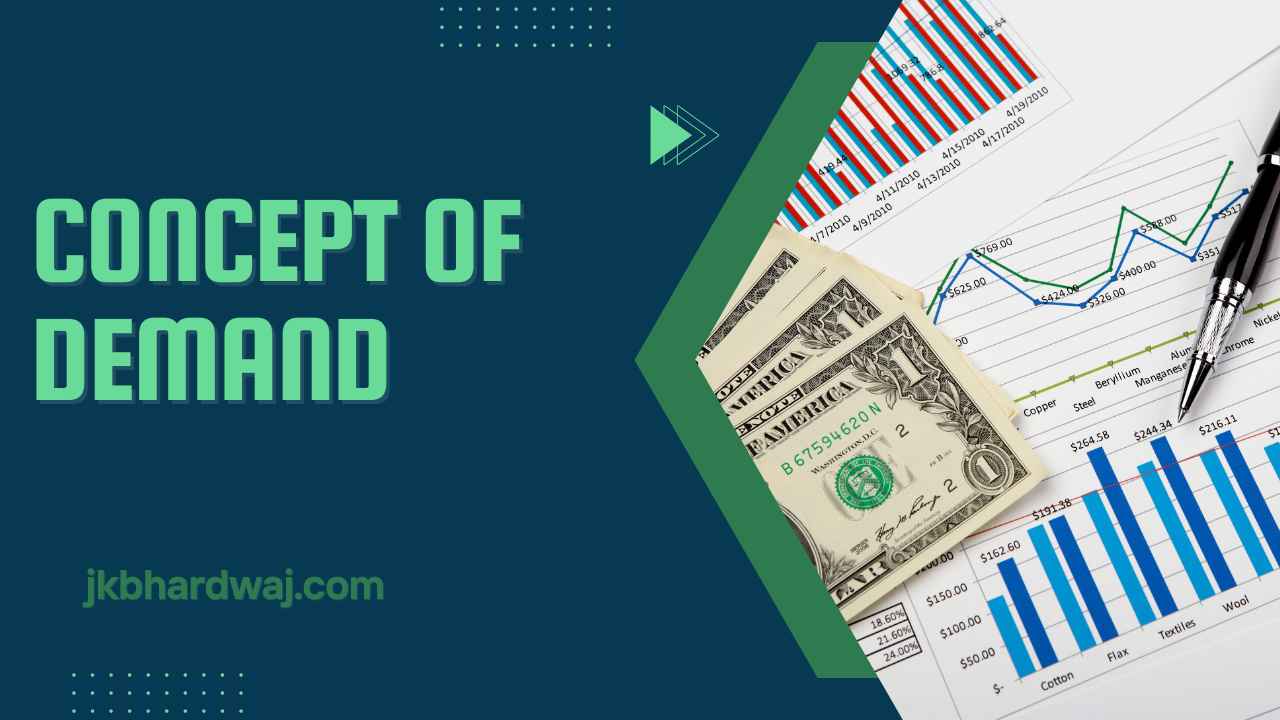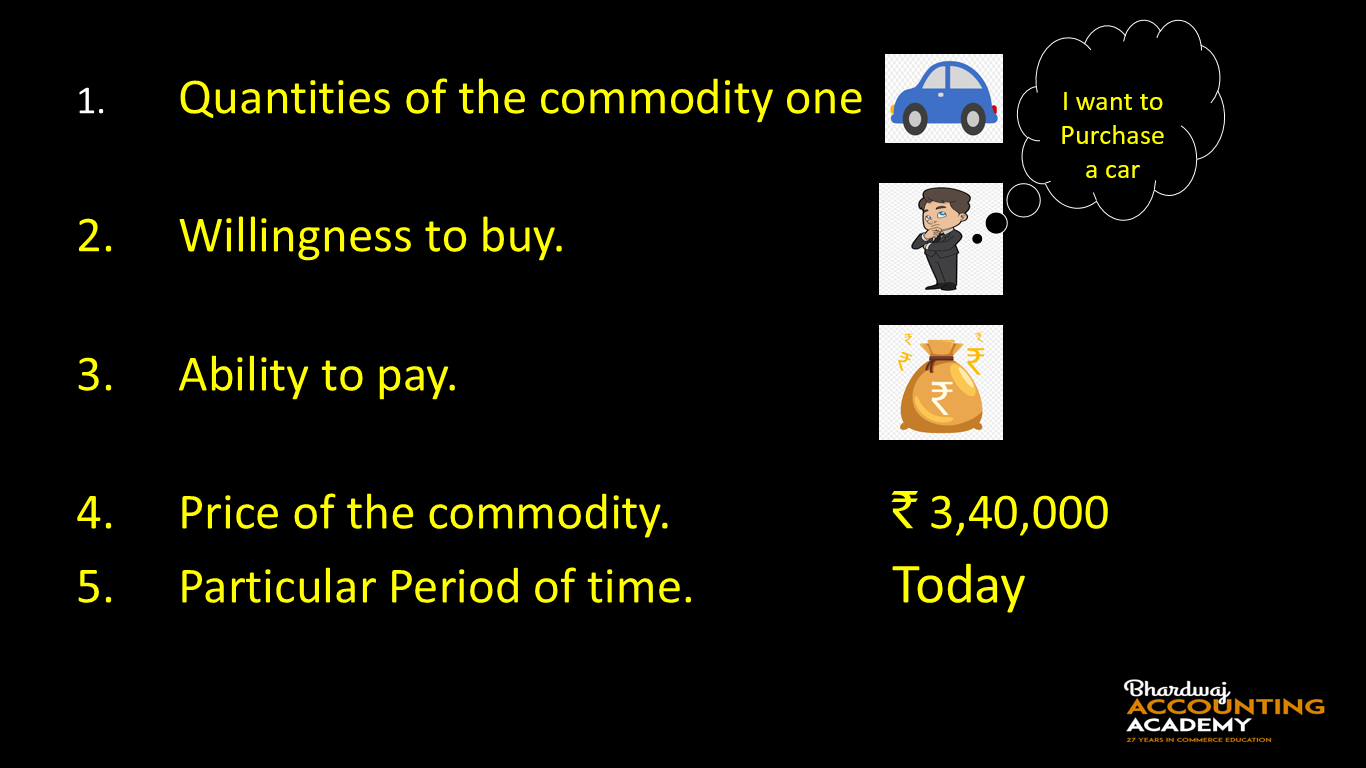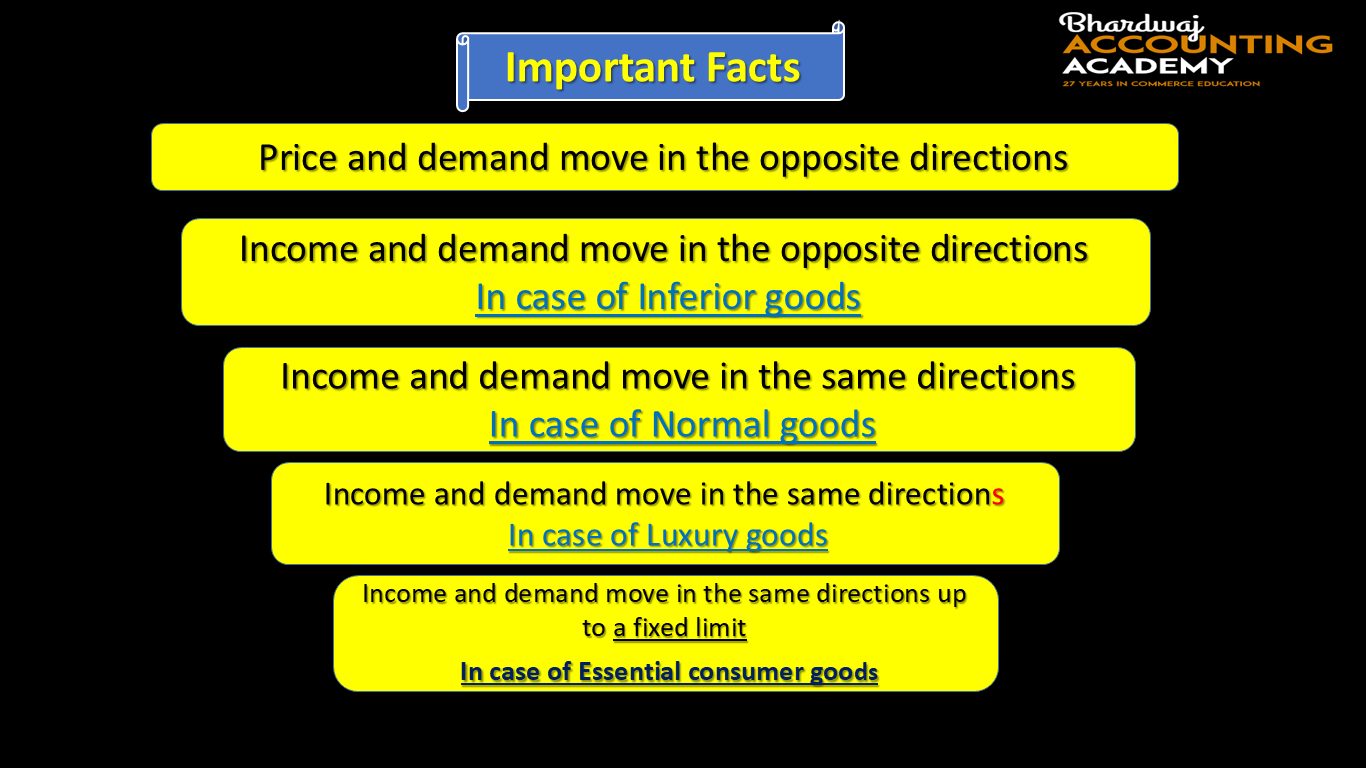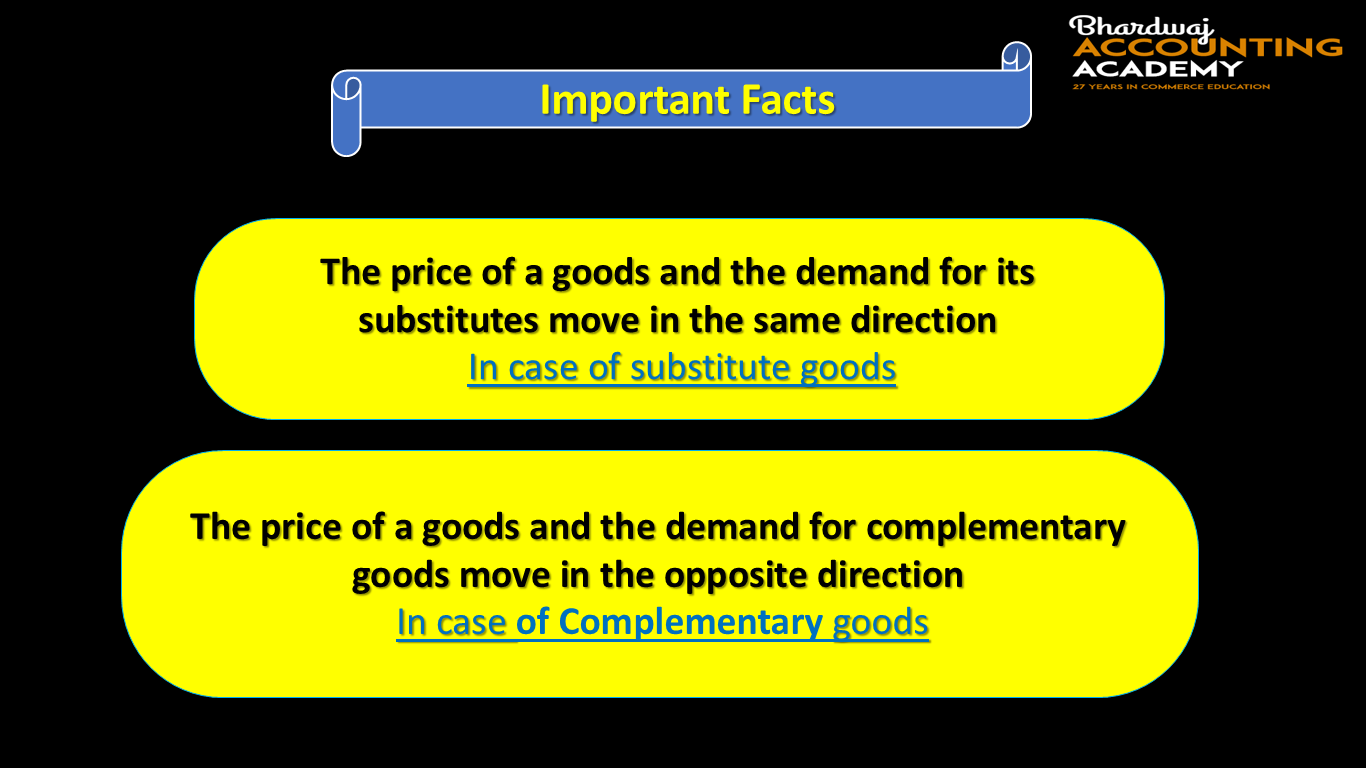Table of Contents
Concept of Demand
Demand refers to the quantity of a commodity that consumers are willing and able to purchase or buy, at each possible price during a particular or given period of time.
(quantity of a commodity + Sufficient Purchasing Power + Willingness to Spend + Time + Price )
Essential Elements of Demand
- Quantities of the commodity
- Willingness to buy.
- Ability to pay.
- Price of the commodity.
- particular Period of time. (The time period may be a day, a week, a month, a year or any other period.)
Definition and Concept of Demand
- According to prof. Pension- ‘’Demand is an Effective Desire’’. (Desire, willingness to buy, and ability to pay)
- According to prof. J.S.Mill- ‘’Demand is the quantity of a commodity demanded at a particular price’’.
- According to prof. Benhum- ‘’ Demand is the quantity of a commodity demanded at a particular time and at a particular price’’.
- According to Prof Hibdon, “Demandmeans the variousquantities of goods that would be purchased per time period at different prices in a given market.”
Read: Meaning of Business
Types of Demand
Individual Demand
Individual demand refers to the quantity of a commodity that an individual consumer is willing and able to buy, at each possible price during a given period of time.
Market Demand
Concept of Market demand states that the quantity of a commodity that all the consumers are willing and able to buy, at each possible price during a given period of time.
Joint Demand
Joint demand refers to the demand for two or more goods that are used jointly or demanded together.
Example: Mobile Phone, batteries, and sim cards are jointly demanded. One without the others is of little use.
Composite Demand
Composite Demand refers to the demand for goods that have multiple uses. or
demand for goods that have multiple uses is called composite demand.
Example: the available steel in an economy can be used in the production of trucks, cars, scooters, refrigerators, etc.
EX-ANTE DEMAND
Ex-ante demand refers to the amount of goods that consumers want to buy or are willing to buy during a particulars time period.
EX-POST DEMAND
Ex-post demand refers to the amount of the goods that the consumers actually purchase during a specific period. It is the amount of goods actually bought.
DIRECT DEMAND
Direct demand refers to the demand for Products or Commodities or services which satisfy our wants directly.
Or
Direct demand refers to the demand of Products that are directly consumed by people.
For example, all consumer goods satisfy our wants directly, so they are said to have direct demand.
DERIVED DEMAND OR INDIRECT DEMAND
The demand for a commodity that arises because of the demand for other commodity is called derived demand.
Thus, the demand for labor/labour which helps us in making a house in a case of indirect or derived demand. The demand for labor/labour is called derived demand because its demand is derived from the demand of a house.
An example of derived demand is an increase in the need for wood because of the increase in the need for furniture.
other example, the demand for large-screen televisions creates a derived demand for home theater products such as audio speakers, amplifiers.
other example, the demand for construction of houses creates a derived demand for labor/labour, steel, bricks, stones,cement wood etc. Demand for a factors of production
INCOME DEMAND
Income demand refers to a relationship between the Income of consumer and the quantity demanded of a commodity , assuming that other things(factors) remaining constant.
Generally ,there is a direct relationship between the income of the consumer and his demand for a product.
Increase in the income of a consumer would automatically increase the demand for products by him/her, while other factors are at constant, and vice versa.
PRICE DEMAND
Price demand refers to a relationship between the price of the commodity and the quantity demanded of a commodity, assuming that other things(factors) remaining constant.
There is an inverse relationship between quantity demanded and its price
Thus we can say that there is an indirect relation between the price of a commodity and its quantity demanded.
| Price per unit of commodity X
(Px) |
Quantity demanded of commodity X
(Dx)
|
| 100 | 500 |
| 200 | 400 |
| 300 | 300 |
CROSS DEMAND
Cross-demand refers to a relationship between the demand of a given commodity and the prices of other related commodities, assuming that other things(factors) remain constant.
In other words, demand refers to a change in the quantity demanded of a good when the price of a related good changes.
When the demand for a commodity depends not on its price but on the price of other related commodities, it is called cross demand.
Determinants of Demand
OR
What are the Factors Affecting Demand
The factors that affect the demand for a commodity are known as Determinants of demand/ Factors affecting demand. The Important determinants of demand are as follows:-
- Price of the commodity
- The income of the consumer
- Tastes and Preferences of Consumers
- Price of Related Goods
- Future Expectations of Consumers
- Effect of Advertisements
- Distribution of Income in the Society
- Growth of Population
- Government Policy
- Climatic Conditions
- Consumer credit facilities
- Demonstration Effect
1.Price of the commodity-
The basic concept of demand states “the quantity of a commodity that consumers are willing and able to purchase or buy” Thus price of the commodity is one of the key factor affecting the demand.
Own price of the commodity is the most important factor affecting demand for the given commodity.
There is an inverse relationship between the price of the commodity its quantity demanded.
When own price of a commodity falls, its demand rises and when own price rises, its demand falls.
The demand for a product decreases with increase in its price and demand for a product increases with decrease in its price while other factors are constant.
Thus we can say that there is an indirect relation between the price of a commodity and its quantity demanded.
2.Income of the consumer-
Income of the consumer (Y) is another important factor which affecting demand for the given commodity. The income of a consumer affects his/her purchasing power.
Generally ,there is a direct relationship between the income of the consumer and his demand for a product. Increase in the income of a consumer would automatically increase the demand for products by him/her, while other factors are at constant, and vice versa.
The income-demand relationship can be analyzed by grouping goods into four categories, namely,
a.Essential consumer goods,
b.Normal goods,
c.Inferior goods,
d.Luxury goods.
a.Essential consumer goods-
Essential consumer goods refer to goods that are consumed by all the people in society. For example, food grains, soaps, oil, cooking fuel, salt, matchbox.
The quantity demanded basic consumer goods increases with an increase in the income of a consumer, but up to a fixed limit, while other factors are constant.
b.Normal goods-
Normal Goods refer to goods whose demand increases with increase in the consumer’s income.
For example, goods such as clothing, vehicles, television, washing machine and food items, are demanded in relatively increasing quantity with increase in consumer’s income.
The demand for normal goods varies due to different rate of increase in consumers income.
Demand varies directly with income level. Income effect is positive
c.Inferior goods-
Inferior Goods refer to goods whose demand decreases with increase in the income of consumers and increase with the decrease in the income.
For example, a consumer would prefer to purchase wheat instead of millet(baajara) and cooking gas instead of kerosene, with increase in his/her income. In such a case, millet and kerosene are inferior goods for the consumer.
However, these two goods can be normal goods for people having lower level of income.
Therefore, we can say that goods are not always inferior or normal; it is the level of income of consumers and their perception about the need of goods.
Demand varies inversely with income level. Income effect is negative.
d.Luxury goods-
Luxury Goods refer to goods whose demand increases with increase in consumer’s income.
Luxury goods are used for the pleasure and esteem(reputation) of consumers.
For example, expensive jewellery items, luxury cars, antique paintings and wines, Rolex watches and air travelling.
Demand varies directly with income level.Income effect is positive
3.Tastes and Preferences of Consumers-
Tastes and Preferences of Consumers Play a major role in influencing the demand of a product.
*Demand for a particular commodity also changes with the changes in taste and preferences of the consumers.
The tastes and preferences of consumers are affected due to various factors such as……
Life styles, Social customs(rivaaj), Common habits, Change in fashion, Change in standard of living, Religious values and age. A change in any of these factors leads to change in the tastes and preferences of consumers.
Changes in taste and preferences of the consumers As a results changes the demand for a particular commodity.
4.Price of Related Goods-
Demand for the given commodity is also affected by change in prices of the related goods.
The effect depends on the nature of related goods. Related goods are of two types.
- Substitute Goods: Substitute goods are those goods which can be used in place of one another for satisfaction of particular want like….. 1.Tea and coffee. 2. Coke and Pepsi.
- Pen and Pencil. 4. CD and DVD
- Groundnut oil and sunflower oil 6. Jowar and bajra
Since Tea is a substitute for Coffee, if the price of coffee increases, the consumers can shift to tea, and hence, the consumption of tea is likely to go up. On the other hand, if the price of coffee decreases, the consumption of tea is likely to go down.
- Complementary Goods: Complementary goods are those goods which are used together to satisfy a particular want or Goods which are consumed together are called complementary goods., like…..
- Tea and sugar. 2. Pen and Ink.
- Car and petrol. 4. Bread and butter.
- Brick and Cement 6. Pen and Refill
Since Car and petrol are used together, an increase in the price of petrol is likely to decrease the demand for car and a decrease in the price of petrol is likely to increase the demand for car.
In general, the demand for a goods moves in the opposite direction of the price of its complementary goods. The complementary goods are inversely related to each other.
5.Future Expectations of Consumers-
Consumer’s expectation about changes in prices in future and availability of goods will also affect the demand for a commodity.
If prices are expected to rise in future, consumers will make purchases in advance.
For example, if consumers expect that the prices of petrol would rise in the next week, then the demand of petrol would increase in the present.
On the other hand, consumers would delay the purchase of products whose prices are expected to be decreased in future
For example, if consumers expect that the prices of sugar would fall in the next week, then the demand of sugar would decrease in the present.
Moreover, the scarcity (Shortage) of specific products in future would also lead to increase in their demand in present.
The possibility of future technological development also affects the current demand for product.






